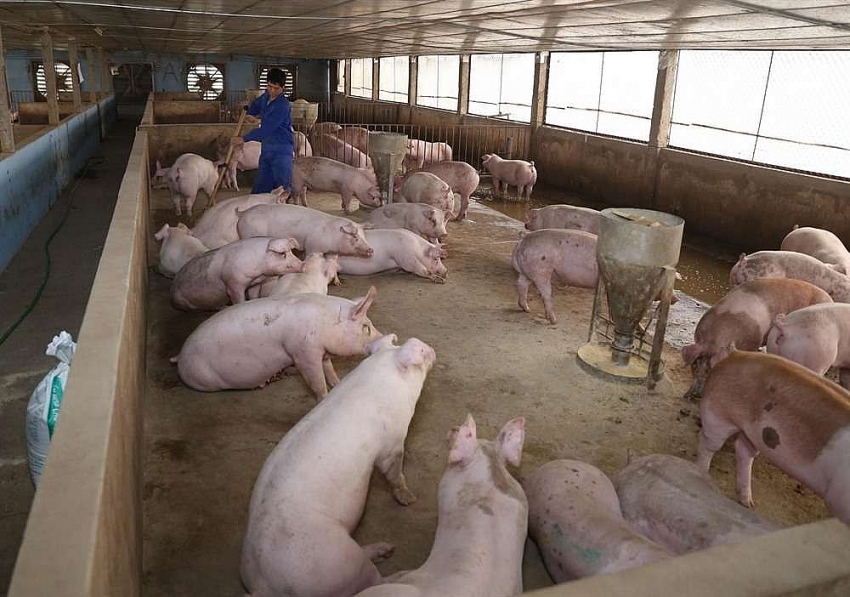Forming value chains to enhance competitiveness for pig farmers
 |
| Pigs are raised in a farm belonging to Bui Duc Luan in Son Vi Commune, Lam Thao district in the northern province of Phu Tho. Farmers are urged to form value chain to enhance the competitiveness for their products. - VNA/VNS Photo Vu Sinh |
According to Fred Unger, a scientist from the International Livestock Research Institute (ILRI), pork is an important part of the Vietnamese diet. Additionally, more than 70 per cent of meat consumption is supplied by small scale producers.
While Vietnamese consumers have a strong preference for fresh, un-chilled pork sold at traditional markets, increasing concerns over food safety have been expressed by Vietnamese consumers, he said at a regional symposium on research into smallholder pig production, health and pork safety which ended in Hanoi on Friday.
Research conducted since 2013, including risk profiling and assessment for biological and chemical hazards, a cost of illness study and most recently a food safety performance assessment of a range of current pork value chains in four provinces of northern Vietnam have showed that pork is not safe. Between 44 and 82 per cent of pork sampled was contaminated with Salmonella, a group of bacteria that normally inhabit the intestines of animals and human.
Unger said that contamination occurred mainly during the slaughtering and retail process.
Despite effort paid to the production of safe pork, it has not yet reached a significant share of the market in Vietnam. He also pointed out that key constraints to the uptake including high cost of adoption, lack of visible benefits from changing behaviour and low consumer trust.
To overcome these constraints, Unger suggested that focus would be on gradual improvements to the food system in place, rather than introducing a new system and incentive-based interventions.
The fact that Vietnam has joined the Comprehensive and Progressive Agreement for Trans-Pacific Partnership (CPTPP) was also a challenge for the animal husbandry industry as the requirements for product quality and traceability are set higher. Thus, farmers needed to join value chains to meet the demand for producing and supplying safe pork for the market, experts said.
Le Thi Thanh Huyen, from the National Institute of Animal Science, said individual households faced poor competitiveness in the market and found it difficult to access resources.
Once smallholder alliances form cooperatives or groups of producers, it would be easy for them to solve capital problems, searching for consumer markets as well as building brands for products and traceability.
While indigenous pigs, such as Ban pork, are preferred by consumers and able to be sold at a high price, awareness of food safety is considered very poor among ethnic farmers, Huyen said.
A survey conducted in Da Bac District, Hoa Binh Province, where Ban pig production is promoted by the Government, showed that most thought safe food could be detected by its physical appearance and blamed chemicals in food as the main cause of cancer, she said. All interviewed consumers thought well cooked pork is safe while fewer people had this view among other stakeholders.
Huyen said better communication was needed to improve the awareness of food safety among different stakeholders along the Bản pork value chain. It is expected that by improving their practices, farmers’ livelihoods would be enhanced by giving them the opportunity to access potential marketing and branding options.
According to Nguyen Thi Duong Nga from Vietnam National University of Agriculture, the forming of cooperatives was to serve three purposes – to buy feed in bulk at cheaper prices and quality; collecting pigs to sell to slaughterhouses and big traders; to slaughter pigs and supply supermarkets and institutional buyers.
The challenges in the application of good practices in the animal production value chain include the synchronisation of market infrastructure, processing and retail; price, food safety monitoring, consumer awareness and trust.
To deal with the above-mentioned problems, Nga said, incentives should be offered for value chain upgrades including favourable conditions for good practices and communication to consumers about the product.
According to Dieter Schillinger, ILRI Deputy Director General, factors to develop value chains include health, feed and pig genes.
Good feed could help bring about high quality pork. Given the current climate, some types of pigs could easily adapt to adverse weather.
Regarding health, he said, it was necessary to enhance the veterinary system to better control diseases as well as biosecurity and vaccines to ensure the health of the pig herd.
The establishment of value chains in animal husbandry was the right direction because it would help ensure food safety and traceability for consumers, he said.
What the stars mean:
★ Poor ★ ★ Promising ★★★ Good ★★★★ Very good ★★★★★ Exceptional
 Tag:
Tag:
Related Contents
Latest News
More News
- Protect what’s next: towards a future free from meningococcal group B disease (December 05, 2025 | 18:00)
- New ILO report offers policy recommendations for disability inclusion (December 04, 2025 | 15:18)
- Maternal job loss may affect children’s mental health, research shows (December 03, 2025 | 19:11)
- Women lead Vietnam’s shift to climate-resilient agriculture (December 03, 2025 | 19:10)
- Experts highlight unpaid care work as key barrier to gender equality (December 03, 2025 | 15:15)
- Opportunities and inequalities for women workers in Vietnam's garment industry (December 03, 2025 | 09:00)
- Vietjet flights carry love to devastated central region (November 28, 2025 | 11:35)
- New initiative to boost the fight against domestic violence (November 26, 2025 | 10:00)
- South Korea funds IOM relief for Vietnam’s typhoon-affected communities (November 24, 2025 | 15:33)
- AI and human-centred values set to shape the future of HR in Vietnam (November 21, 2025 | 18:04)
























 Mobile Version
Mobile Version